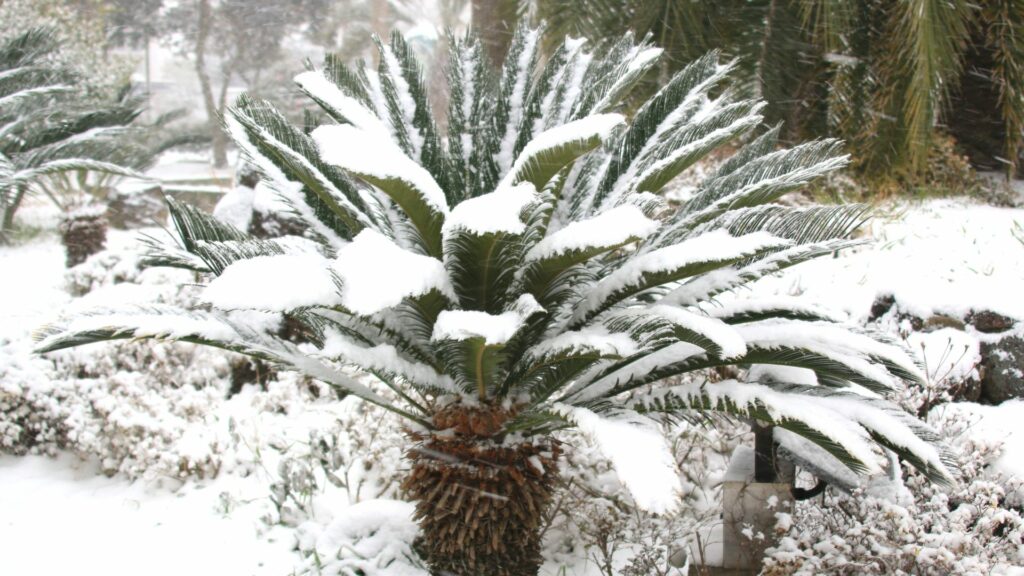Cold weather and frosty conditions can damage your palm trees in several ways. Severe cold weather typically lowers a palm’s growth rate. It also slows down root development, ultimately causing significant damage to the tree trunk, the leaves, the roots, the heart of the palm tree, and all the surrounding tissues.
Protecting palm trees from frost involves feeding the tree fertilizer months before the cold season begins, mulching and watering, making use of tree covers, wraps, or blankets, adding sources of heat such as holiday lights, making use of fungicide sprays, or building temporary greenhouses.
Knowing when (and how) to act to give your palm tree the best protection against frost is imperative in its chance of survival. Let’s unpack everything you need to know about helping your palm tree thrive in cold conditions.
How to Protect Palm Trees from Freezing

As peculiar as it may sound, a little cold weather is actually good for your palm tree as it promotes dormancy and equips the tree to handle the cold better.
So, it’s best to winterize your palms slowly and allow them to acclimate to cooler weather conditions gradually. Unless, of course, there is a sudden or unexpected drop in temperatures.
Protecting your palm tree from frost involves a little research. Still, we’ve made the homework more effortless for you with the following steps:
Step 1: Prepare the Palm
It is essential to be proactive by adding fertilizer to your palm tree in Spring, Summer, and Fall and not explicitly waiting until Winter begins. Preparing your palm and keeping it in tip-top form before Winter gives it the best chance of surviving the cold.
Use a slow-release fertilizer at a ratio of 1 and a half pounds per 100 square feet of the palm tree’s canopy and then water thoroughly.
Step 2: Palm Mulching
To boost palm tree survival and minimize root and leaf damage, heavy mulching is the most effective way of protecting your palm as it stops frost from invading too deeply into the soil.
Heavy mulching before the cold arrives, at a depth of 3 to 4 inches, prevents the ground near the tree from freezing deeply, thus protecting the roots and the tree’s lower trunk. Mulching is the best way to insulate the tree’s roots.
Adding mulch keeps the underground temperatures relatively constant, protecting the roots from cold damage caused by temperature fluctuations.
Step 3: Heavy Watering
It is vital to ensure that your palm has access to plenty of water, so by heavy watering, you can be sure that the soil maintains a constant amount of moisture throughout the cold months and that your tree is well-watered.
Water uptake of a palm tree drops significantly during colder temperatures, particularly numbers below 40 degrees Fahrenheit, so remember to water your palm generously anytime a cold spell is on its way.
Step 4: Cover the Palm
Covering your palm tree is wise when cold weather or a freeze is imminent. A simple blanket is adequate for smaller palms. In contrast, more enormous palm trees would benefit from a frost cloth, burlaps, horticultural fleece, or landscape fabric.
Avoid using absorbent materials such as cotton, as they trap moisture, which may cause trunk rot. The best way to cover a plan is to wrap the material around the trunk and secure it with duct tape. Also, wrap the material around the lower leaves, bunching them closely together.
For the much taller palm trees, a licensed arborist can do a great job of wrapping your tree to protect its main bud, also known as the heart of the palm tree.
Step 5: Add Heat
Adding some form of warmth is also a highly effective way of raising temperatures on a cold winter’s day. Consider using a heat lamp or small propane heater/fan placed at a safe distance from the palm.
A more fun and festive way of protecting your palm trees from frost would be to wrap a string of Christmas/holiday lights around the tree. These lights can quickly raise the temperature by 2-3 degrees Fahrenheit.
Ensure to choose a strand of lights that gives off heat. LED lights won’t help to keep your palm warm.
Step 6: Spray the Palm
Spray the palm leaves’ tops and undersides with an anti-transpirant before the temperatures drop below 40 degrees Fahrenheit. This spray creates a film on the leaves, enabling them to retain moisture and avoid unnecessary water loss during cold temperatures.
A fungicidal solution should also be used before the cold spell hits. This spray keeps the fungi and bacteria levels on the lower side. Stressed palm trees are more susceptible to bacterial and fungal infections as cold temperatures approach.
Step 7: Build a Greenhouse
Building a temporary greenhouse around your palm is another excellent way to protect palm trees from frost. With just a bit of time, thought, and effort, one could quickly assemble a wooden frame around the palm, covering it with a double plastic sheet.
You could even add a heat source to the greenhouse, too.
Can Palm Trees Survive Winter?
The type of palm tree you have has a great deal to do with its tolerance to frost and cold temperatures. There is a plethora of palm species out there, and the physical size and overall health of your palm tree also determine the tree’s chances of survival.
Regularly fertilizing your palm tree throughout the year with a good quality fertilizer and paying attention to the steps above will maximize your palm’s potential to survive the winter months unscathed.
Knowing the exact type of palm you own is also beneficial to its survival, as each species requires attention to its specific needs. Knowing exactly what climate your palm prefers will also enable you to make knowledgeable decisions regarding its flourishment.
What Temperature will Kill a Palm Tree?
A temperature that will kill a palm tree also varies from species to species as their cold tolerances certainly aren’t identical. The cold tolerance of palms also depends on their summer care and plant age.
Generally speaking, Tropical palm trees prefer temperatures ranging from 60-80 degrees Fahrenheit, but some hardy, cold-tolerant palms may withstand significantly lower temperatures, examples of species being:
- The Paurotis Palm: Withstands temperatures as low as 25 degrees Fahrenheit.
- The Cabbage Palm: Withstand temperatures as low as 10 degrees Fahrenheit.
- The Coconut Palm: Cannot tolerate any cold at all.
How to Keep a Palm Tree Alive Indoors during Winter
Before the cold seeps in, one needs to timeously winterize your indoor palm trees with a bit of extra care and a few adjustments such as:
- Creating a warm indoor environment with 60-80 degrees Fahrenheit temperatures.
- Placing the palm near a sunny window.
- Making use of grow lights for adequate lighting.
- Watering sparingly and allowing topsoil to dry in between watering sessions.
- Maintaining humidity levels using humidifiers or a tray of water and pebbles.
- Regularly inspecting the palm for pests and diseases.
- Dusting the leaves regularly to ensure a thriving palm tree throughout Winter.
Final Thoughts
Protecting your palm trees from frost involves a few preventative measures, but keeping your tree healthy and robust all year round is essential to survive the winter months.
At the first sign of cold weather, mulch your palm tree heavily, saturate the roots thoroughly, cover the sensitive parts, use fungicide sprays, and adorn your palm with Christmas lights.

